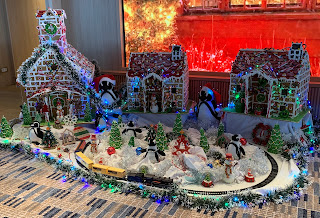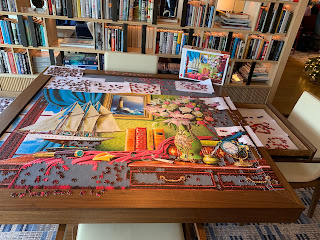We sailed into Ketchikan under drizzly skies. Later we found out why. This is one of the rainiest cities in Alaska. The legend tells of a man who married a bear, had 3 bear cubs with her and later saw and talked to his former (human) wife after promising his bear wife that he would never see or talk to the human wife again. The bear wife was a bit upset and the two of them, bear wife and man husband got into an argument and started arguing. It came to blows. The 3 bear cubs, now fully grown came upon the scene and killed their man father. The female bear wife was so distraught that she climbed to the top of the mountain over Ketchikan and, staying there, cries a lot. This is the rain that falls on Ketchikan. Today she was not so sad. We had some blue skies.
Our 2 tours today both had to do with “Totem Poles,” or just
“totems” as the Tlinget people prefer.
The first took us to a park with dozens of totems, both large and
small. Unfortunately, I am still unable
to transfer pictures from either my phone or my camera. I am going to see the resident ´specialist”
tomorrow for some help.
The second tour took us to the Saxman Totem Park where we
heard the stories behind some of the more famous totems.
There are several types of totems. Some are identity totems. They are used to identify the tribe living in
a village. For instance, if the tribe is
the Eagle Beaver Clan, the top of the pole would have a representation of an eagle. The bottom of the pole would have a
representation of a beaver. In between
would be representations of important events or people in the village. These totems would be place where they could
be seen from the river or other body of water.
Other totems were to honor a person or event. Still others were to shame a person. More about these later.
One of the major social events in their lives was a “potlach.” If two tribes were not getting along, or if
relations were uncertain, then a tribe would send a message inviting the other
tribe to a potlach. The other tribe
would then come to visit for a few days.
This is why the river-side totems were so important. The visitors would see the totem and know
that they were at the right place. The
visitors were greeted with dancing to the beat of a drum, given food and
lodging for 2 or 3 days and given gifts of all sorts. At the end of the potlach, they would be sent
home with more food and gifts. In
return, they were required to invite the original tribe to their village within
2 to 3 months for a similar party or Potlach.
If they did, there was peace between the tribes. If not, there might be war.
One “Potlach” story involves the purchase of Alaska from
Russia. Seward came to Alaska and was
welcomed by at least 4 different tribes to be entertained and honored at potlaches. He was fed, boarded and given extensive
gifts. Therefore, he should have invited
those tribe to his home and treated them as he had been treated. He did no such thing. He simply packed up and went home. This was a major insult, so the Tlinget
village carved a “Shame” totem. The top
has an image of Seward sitting on a large box representing all the gifts he
accepted. The rest of the pole is
blank. Seward is wearing a potlach hat
which looks like a large upside-down funnel.
It has 4 stripes, indicating that he had attended 4 potlaches. Some of Sewards descendants visited the
Saxman village and asked what they could do the “redeem” their ancestor. They were told that they would have to pay
the villages for the value of gifts given to Seward, which would amount to at
least a couple million dollars. The
relatives decided to leave Sewward on top of the Shame totem.

































